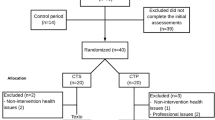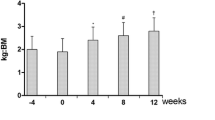Abstract
Background
To promote optimal neuromuscular and cardiovascular gains in older adults, it seems crucial to investigate the effects of different combined training volumes in this population. Thus, the present study aimed to compare the effects of combined muscle power training (MPT) and endurance training (ET) with different volumes on functional and hemodynamic parameters in previously trained older adults.
Methods
Twenty-five older adults were randomly assigned to either the lower-volume group (LVG; n = 13) or the higher-volume group (HVG; n = 12). In the LVG, participants performed 1 set of 6 repetitions for each exercise, followed by 10 min of walking exercise. In the HVG, participants performed 2 sets of 6 repetitions for each exercise, followed by 20 min of walking exercise. Lift from the ventral decubitus position (LPDV), timed up-and-go (TUG), systolic blood pressure (SBP), and diastolic blood pressure (DBP) were assessed before and after 8 weeks.
Results
Significant increases in LPDV test occurred in both groups after 8 weeks (p < 0.05). Additionally, significant improvements in TUG performance occurred in both groups from week 0 to week 8 (p < 0.05). However, no significant changes were observed between groups in functional parameters (p > 0.05). SBP and DBP remain unchanged (p > 0.05) in both groups over the experimental period.
Conclusions
These findings indicate that lower-volume and higher-volume of combined MPT and ET promoted improvements in functional parameters. This study has an important practical application, as it indicates that regardless of the volume (lower or higher), comparable improvements are observed in functional parameters in previously trained older adults.


Similar content being viewed by others
Data availability
The datasets generated during and/or analyzed during the current study are available from the corresponding author upon reasonable request.
References
Cadore EL, Pinto RS, Reischak-Oliveira Á et al (2018) Explosive type of contractions should not be avoided during resistance training in elderly. Exp Gerontol 102:81–83. https://doi.org/10.1016/j.exger.2017.12.003
Coelho-Júnior HJ, Uchida MC, Picca A et al (2021) Evidence-based recommendations for resistance and power training to prevent frailty in community-dwellers. Aging Clin Exp Res 33:2069–2086. https://doi.org/10.1007/s40520-021-01802-5
Fragala MS, Cadore EL, Dorgo S et al (2019) Resistance training for older adults: position statement from the national strength and conditioning association. J Strength Cond Res 33:2019–2052. https://doi.org/10.1519/JSC.0000000000003230
Radaelli R, Trajano GS, Freitas SR et al (2023) Power training prescription in older individuals: is it safe and effective to promote neuromuscular functional improvements? Sports Med 53:569–576. https://doi.org/10.1007/s40279-022-01758-0
Tschopp M, Sattelmayer MK, Hilfiker R (2011) Is power training or conventional resistance training better for function in elderly persons? A meta-analysis. Age Ageing 40:549–556. https://doi.org/10.1093/ageing/afr005
Miszko TA, Cress ME, Slade JM et al (2003) Effect of strength and power training on physical function in community-dwelling older adults. J Gerontol A Biol Sci Med Sci 58:171–175. https://doi.org/10.1093/gerona/58.2.m171
Ramírez-Campillo R, Castillo A, de la Fuente CI et al (2014) High-speed resistance training is more effective than low-speed resistance training to increase functional capacity and muscle performance in older women. Exp Gerontol 58:51–57. https://doi.org/10.1016/j.exger.2014.07.001
Izquierdo M, Merchant RA, Morley JE et al (2021) International exercise recommendations in older adults (ICFSR): expert consensus guidelines. J Nutr Health Aging 25:824–853. https://doi.org/10.1007/s12603-021-1665-8
Roberson KB, Potiaumpai M, Widdowson K et al (2017) Effects of high-velocity circuit resistance and treadmill training on cardiometabolic risk, blood markers, and quality of life in older adults. Appl Physiol Nutr Metab 43:822–832. https://doi.org/10.1139/apnm-2017-0807
Oliveira-Dantas FF, Browne RAV, Oliveira RS et al (2021) Effect of high-velocity resistance exercise on 24-h blood pressure in hypertensive older women. Int J Sports Med 242:41–47. https://doi.org/10.1055/a-1202-1536
Bavaresco Gambassi B, Nobre I, Prazeres J et al (2023) Impact of dynamic explosive resistance exercise with elastic bands on pulse pressure in hypertensive older adults: a randomized crossover study. Blood Press Monit 28:208–214. https://doi.org/10.1097/MBP.0000000000000650
Ferrari R, Kruel LF, Cadore EL et al (2013) Efficiency of twice weekly concurrent training in trained elderly men. Exp Gerontol 48:1236–1242. https://doi.org/10.1016/j.exger.2013.07.016
Sousa TMDS, Rodrigues B, Uchida MC et al (2017) Novel combined training approach improves sleep quality but does not change body composition in healthy elderly women: a preliminary study. J Aging Res. https://doi.org/10.1155/2017/8984725
da Silva LXN, Teodoro JL, Menger E et al (2018) Repetitions to failure versus not to failure during concurrent training in healthy elderly men: a randomized clinical trial. Exp Gerontol 108:18–27. https://doi.org/10.1016/j.exger.2018.03.017
Cadore EL, Menger E, Teodoro JL et al (2018) Functional and physiological adaptations following concurrent training using sets with and without concentric failure in elderly men: a randomized clinical trial. Exp Gerontol 110:182–190. https://doi.org/10.1016/j.exger.2018.06.011
Cadore EL, Pinto RS, Teodoro JL et al (2018) Cardiorespiratory adaptations in elderly men following different concurrent training regimes. J Nutr Health Aging 22:483–490. https://doi.org/10.1007/s12603-017-0958-4
Teodoro JL, Izquierdo M, da Silva LXN et al (2020) Effects of long-term concurrent training to failure or not in muscle power output, muscle quality and cardiometabolic risk factors in older men: a secondary analysis of a randomized clinical trial. Exp Gerontol 139:111023. https://doi.org/10.1016/j.exger.2020.111023
Gambassi BB, Fontoura GM, Moura J et al (2021) Impact of dynamic combined training method on locomotor capacity in healthy elderly. JEP Online 24:74–82
Müller DC, Boeno FP, Izquierdo M et al (2021) Effects of high-intensity interval training combined with traditional strength or power training on functionality and physical fitness in healthy older men: a randomized controlled trial. Exp Gerontol 149:111321. https://doi.org/10.1016/j.exger.2021.111321
Cadore EL, Pinto RS, Lhullier FL et al (2010) Physiological effects of concurrent training in elderly men. Int J Sports Med 31:689–697. https://doi.org/10.1055/s-0030-1261895
Cadore EL, Izquierdo M (2013) How to simultaneously optimize muscle strength, power, functional capacity, and cardiovascular gains in the elderly: an update. Age (Dordr) 35:2329–2344. https://doi.org/10.1007/s11357-012-9503-x
Ferrari R, Fuchs SC, Kruel LF et al (2016) Effects of different concurrent resistance and aerobic training frequencies on muscle power and muscle quality in trained elderly men: a randomized clinical trial. Aging Dis 7:697–704. https://doi.org/10.14336/AD.2016.0504
Radaelli R, Brusco CM, Lopez P et al (2018) Higher muscle power training volume is not determinant for the magnitude of neuromuscular improvements in elderly women. Exp Gerontol 110:15–22. https://doi.org/10.1016/j.exger.2018.04.015
Radaelli R, Brusco CM, Lopez P et al (2019) Muscle quality and functionality in older women improve similarly with muscle power training using one or three sets. Exp Gerontol 128:110745. https://doi.org/10.1016/j.exger.2019.110745
Beck TW (2013) The importance of a priori sample size estimation in strength and conditioning research. J Strength Cond Res 27:2323–2337. https://doi.org/10.1519/JSC.0b013e318278eea0
Alexander NB, Ulbrich J, Raheja A et al (1997) Rising from the floor in older adults. J Am Geriatr Soc 45:564–569. https://doi.org/10.1111/j.1532-5415.1997.tb03088.x
Podsiadlo D, Richardson S (1991) The timed “Up & Go”: a test of basic functional mobility for frail elderly persons. J Am Geriatr Soc 39:142–148. https://doi.org/10.1111/j.1532-5415.1991.tb01616.x
Barroso WKS, Rodrigues CIS, Bortolotto LA et al (2021) Brazilian guidelines of hypertension–2020. Arq Bras Cardiol 116:516–658. https://doi.org/10.36660/abc.20201238
Bavaresco Gambassi B, Lopes Dos Santos MD, Furtado Almeida FJ (2019) Basic guide for the application of the main variables of resistance training in elderly. Aging Clin Exp Res 31:1019–1020. https://doi.org/10.1007/s40520-019-01181-y
Day ML, McGuigan MR, Brice G et al (2004) Monitoring exercise intensity during resistance training using the session RPE scale. J Strength Cond Res 18:353–358. https://doi.org/10.1519/R-13113.1
Borg G (1998) Borg’s perceived exertion and pain scales. Human Kinetics, Champaign
Foster C, Florhaug JA, Franklin J et al (2001) A new approach to monitoring exercise training. J Strength Cond Res 15:109–115
Gambassi BB, Coelho-Junior HJ, Paixão Dos Santos C et al (2019) Dynamic resistance training improves cardiac autonomic modulation and oxidative stress parameters in chronic stroke survivors: a randomized controlled trial. Oxid Med Cell Longev. https://doi.org/10.1155/2019/5382843
Lakens D (2013) Calculating and reporting effect sizes to facilitate cumulative science: a practical primer for t-tests and ANOVAs. Front Psychol 4:863. https://doi.org/10.3389/fpsyg.2013.00863
Espirito Santo H, Daniel F (2018) Calcular e apresentar tamanhos do efeito em trabalhos científicos (3): Guia para reportar os tamanhos do efeito para análises de regressão e ANOVAs (Calculating and Reporting Effect Sizes on Scientific Papers (3): guide to Report Regression Models and ANOVA Effect Sizes). Revista Portuguesa de Investigação Comportamental e Social 4:43–60
Trombetti A, Reid KF, Hars M et al (2016) Age-associated declines in muscle mass, strength, power, and physical performance: impact on fear of falling and quality of life. Osteoporos Int 27:463–471. https://doi.org/10.1007/s00198-015-3236-5
Szlejf C, Suemoto CK, Brunoni AR et al (2019) Depression is associated with sarcopenia due to low muscle strength: results from the ELSA-Brasil study. J Am Med Dir Assoc 20:1641–1646. https://doi.org/10.1016/j.jamda.2018.09.020
Formighieri C, Müller DC, Sáez de Asteasu ML et al (2022) Interindividual variability of adaptations following either traditional strength or power training combined to endurance training in older men: a secondary analysis of a randomized clinical trial. Exp Gerontol 169:111984. https://doi.org/10.1016/j.exger.2022.111984
Coelho-Júnior HJ, Gonçalves IO, Câmara NOS et al (2018) Non-periodized and daily undulating periodized resistance training on blood pressure of older women. Front Physiol 9:1525. https://doi.org/10.3389/fphys.2018.01525
Dos Santos ES, Asano RY, Filho IG et al (2014) Acute and chronic cardiovascular response to 16 weeks of combined eccentric or traditional resistance and aerobic training in elderly hypertensive women: a randomized controlled trial. J Strength Cond Res 28:3073–3084. https://doi.org/10.1519/JSC.0000000000000537
Mota MR, de Oliveira RJ, Dutra MT et al (2013) Acute and chronic effects of resistive exercise on blood pressure in hypertensive elderly women. J Strength Cond Res 27:3475–3480. https://doi.org/10.1519/JSC.0b013e31828f2766
Terra DF, Mota MR, Rabelo HT et al (2008) Reduction of arterial pressure and double product at rest after resistance exercise training in elderly hypertensive women. Arq Bras Cardiol 91:299–305. https://doi.org/10.1590/s0066-782x2008001700003
Acknowledgements
We gratefully acknowledge all the participants who participated in this research and made this project possible.
Funding
None.
Author information
Authors and Affiliations
Contributions
All authors contributed to the study's conception and design. Conceptualization: Material preparation, data collection, and analysis were performed by BBG, ELC, LFCC, TMSS, CTM, AFS, and PAS. Data acquisition: BBG, LFCC, TMSS. Supervision: BBG, LFCC, TMSS. Statistical analysis; BBG, ELC, PAS. The first draft of the manuscript was written by BBG, ELC, LFCC, TMSS, CTM, AFS, PAS, and all authors commented on previous versions of the manuscript. All authors read and approved the final manuscript.
Corresponding author
Ethics declarations
Conflict of interest
All authors declare that there is no conflict of interest.
Ethical approval
This study was performed in line with the principles of the Declaration of Helsinki. Approval by the Ethics Committee at CEUMA University (São Luís, MA, Brazil).
Informed consent
Written informed consent was obtained from all individual participants included in the study.
Additional information
Publisher's Note
Springer Nature remains neutral with regard to jurisdictional claims in published maps and institutional affiliations.
Rights and permissions
Springer Nature or its licensor (e.g. a society or other partner) holds exclusive rights to this article under a publishing agreement with the author(s) or other rightsholder(s); author self-archiving of the accepted manuscript version of this article is solely governed by the terms of such publishing agreement and applicable law.
About this article
Cite this article
Bavaresco Gambassi, B., Cadore, E.L., Chaves, L.F.C. et al. Effects of combined muscle power and endurance training with different volumes on functional and hemodynamic parameters in previously trained older adults. Aging Clin Exp Res 35, 2623–2631 (2023). https://doi.org/10.1007/s40520-023-02572-y
Received:
Accepted:
Published:
Issue Date:
DOI: https://doi.org/10.1007/s40520-023-02572-y




